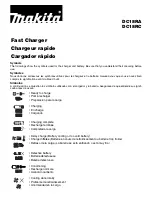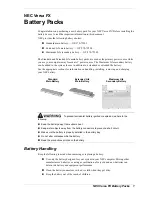
Page | 10
Vent Caps
Ensure that the transport seal film used for preventing electrolyte spillage during transportation has been removed from the vent caps
before charging.
The cell vent caps should be closed during charging.
Vent caps should be kept clean to allow venting of gases produced during charging. Wash ceramic plugs, if soiled, in clean water and
dry them thoroughly before putting them back on the battery.
Check Charger Settings
The chargers float and equalize voltage settings should be checked at least once a year. The proper float and equalize settings should
be verified at the battery terminals.
High water consumption is usually caused by a high float voltage setting of the charger. A high float voltage setting will force more
current into the battery than required and the extra heat generated will cause excessive water loss.
Seeing batteries or cells with low voltages is typical of a system that is being undercharged. If the leads from the charger to the battery
are long or undersized voltage drop will occur and the system will be undercharged. To compensate for voltage drop the charger
settings may need to be increased and checked against the battery terminals.
Capacity/Discharge Testing
Capacity testing (acceptance and performance tests) is used to trend battery aging. The result of a capacity test is a calculation of the
capacity of the battery. The calculated capacity is used to determine whether the battery requires replacement.
Capacity tests should be carried out in accordance with IEEE1106-2005.
In nickel-cadmium batteries, approximately 12 weeks is needed after a previous discharge for the “float effect” to reach its full extent
(see Annex D of IEEE1106 for details). Results of capacity tests that are carried out after less than 12 weeks have elapsed will not be
characteristic of normal operation and the results should not be compared with future performance test results.
Note: SBS does not recommend an acceptance or performance test until the system has been in float service for a minimum of 12
weeks. Results of a test carried out before the system has been on float for 12 weeks will not be considered for warranty purposes.
Test length
SBS recommends discharge times of 1 to 8 hours to an end cell voltage of 1.00- 1.14 Vpc.
For comparison purposes, having the performance test be similar in duration to the battery duty cycle and to the end voltage originally
used for sizing is desirable.
Discharge Rate
Correct discharge rates (in amps) must be chosen from discharge rate tables based on long term float charging ratings.
Performance data is available at
www.sbsbattery.com
or can be supplied by contacting SBS. For trending purposes, the same test
length and rate should be used for each test during the batteries service life.
Temperatures effect on a Capacity/Discharge Test
Discharge tests should be performed between 65°F and 90°F.
For tests of a duration of 1 hour or more, do not adjust the rate of the discharge. The time adjusted capacity calculation allows you to
factor in the temperature correction factor (Kc) after the test is completed.
Acceptance Testing
Acceptance tests may be carried out after the battery has been on float charge for at least 12 weeks without discharging. Although an
acceptance test carried out after less than 12 weeks on float charge will confirm that a battery has adequate capacity, the acceptance
test results cannot be compared with future performance test results because of the “float effect” (see Annex D in IEEE1106-2005 for
details). This condition makes performing an acceptance test that accurately reflects operation in float charging mode impractical.
Performance Testing
Per IEEE a performance test should be made within the first two years of service and at five-year intervals until the battery shows signs
of excessive capacity loss. Annual performance tests of battery capacity should be made on any battery that shows signs of excessive
capacity loss. SBS recommends using the time adjusted method for calculating system capacity as outlined on page 11.






























